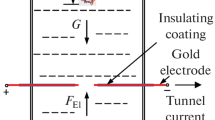Abstract
A mathematical method is introduced to characterize the electrokinetic behavior (electrophoresis) of a biomolecular particle which passes through a specific channel pore on an excitable biological membrane. The basic approach was first proposed by Booth (1950). The system was described by an equation of continuity and an equation of motion in which the driving force involves the diffusion effect, the hydrostatic pressure, and the electrostatic potential. By assuming linear relations between the velocity and the applied electrical field, solutions for the potential, pressure, and velocity were given by a series expansion of the charges on the particle. To examine the influence of ions surrounding the particle and forming an ionic cloud, the Debye–Huckel parameter was introduced. As the thickness of the double layer around the particle increased, the potential, velocity, pressure, and viscosity were changed significantly. The maximum influence was obtained when the radius of the particle became equal to the thickness of the double layer. Although this theory is valid for a charged, spherical, nonconducting particle only, the method is available for evaluating the kinetic behavior of a biomolecule that passes through a channel pore on a cellular membrane.
Similar content being viewed by others
References
RW O’Brien LR White (1978) ArticleTitleElectrophoretic mobility of a spherical colloidal particle J Chem Soc Faraday Trans 2 IssueID74 1607–1626
F Booth (1950) ArticleTitleThe cataphoresis of spherical, solid nonconducting particles in a symmetrical electrolyte Proc R Soc A 203 514
F Booth (1950) ArticleTitleThe electroviscous effect for suspensions of solid spherical particles Proc R Soc A 203 533–546
DC Henry (1931) ArticleTitleThe cataphoresis of suspended particles. Part 1. The equations of cataphoresis Proc R Soc A 133 106–129
HB Bull (1940) ArticleTitleMeasurement of viscosity of egg albumin suspension Trans Faraday Soc 36 80–96 Occurrence Handle10.1039/tf9403500080
H Frohlich R Sack (1946) ArticleTitleTheory of the rheological properties of dispersions Proc R Soc A 185 415–430
MV Smoluchowki (1918) ArticleTitleVersuch einer mathematischen Theorie der koagulationskinetik–kolloider losungen Z Phys Chem 92 129–140
Author information
Authors and Affiliations
Corresponding author
Additional information
This work was presented, in part, at the 8th International Symposium on Artificial Life and Robotics, Oita, Japan, January 24–26, 2003
About this article
Cite this article
Hirayama, H., Itoh, T., Nakaki, Y. et al. Computational dynamics method for evaluating the mobility of charged biomolecules passing through the electrical potential field within the ion selective channel on an excitable membrane. Artif Life Robotics 9, 144–160 (2005). https://doi.org/10.1007/s10015-004-0317-5
Received:
Accepted:
Issue Date:
DOI: https://doi.org/10.1007/s10015-004-0317-5




